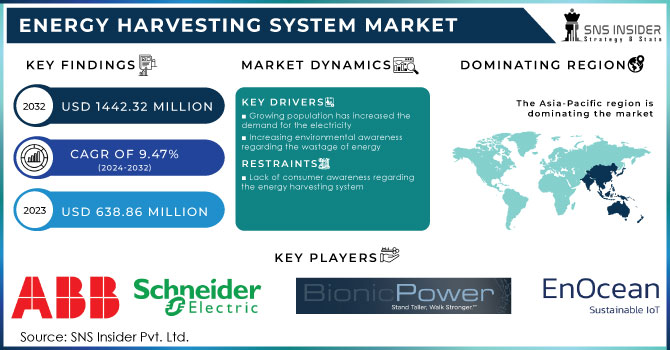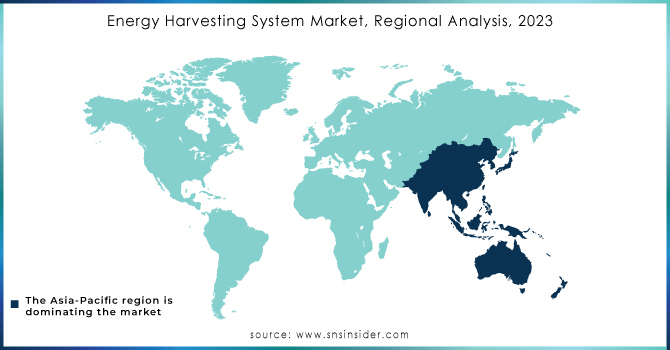Energy Harvesting System Market Report Scope & Overview:

Get More Information on Energy Harvesting System Market- Request Sample Report
The Energy Harvesting System Market size was valued at USD 638.86 million in 2023 and is expected to grow to USD 1442.32 million by 2032 and grow at a CAGR of 9.47% over the forecast period of 2024-2032.
Energy harvesting is also referred to as energy scavenging or microenergy harvesting. It is the technique of capturing and converting small amounts of readily available energy in the environment into usable electrical energy. The produced electric energy is either used directly or stored for later use. Energy harvesting is an alternative source of power for application in a location where no grid power is present.
Energy harvesting system provides an alternative source of electricity in locations where there is a lack of supply of grid power or is inefficient to generate electricity from solar panels or wind turbines. If the harvested energy is low and incapable of powering the device then it is used to extend the battery life. Energy harvesting systems provide unlimited operating life to low-power equipment and also eliminate the need of replacing costly batteries.
The energy harvesting system requires energy sources such as light, heat, vibration, and other three important components such as a harvester or transducer, energy storage, and power management. There is abundant energy in the environment, which can be converted into electrical energy for powering a variety of circuits.
Market Dynamics
Drivers
-
The growing population has increased the demand for the electricity
-
Increasing environmental awareness regarding the wastage of energy
-
Growing government rules and restrictions to reduce the greenhouse gas emission
-
Use of low-power electronic devices in the healthcare industry
-
Increasing adoption of energy harvesting systems in home appliances
The energy in the environment is wasted directly or indirectly but energy harvesting systems have the ability to capture and convert this energy into electricity which is further used in autonomous electronic devices and circuits. This factor is propelling the energy harvesting system market.
Restrain
-
Lack of consumer awareness regarding the energy harvesting system
-
High capital cost of energy harvesting system
Opportunities
-
Technological advancement in energy harvesting system
Challenges
-
Lack of technical expertise in the energy harvesting system
One of the primary challenges facing the energy harvesting system market is the lack of technical expertise in this field. This shortage of knowledge and skills can hinder the development and implementation of effective energy harvesting systems, which are crucial for sustainable energy solutions. Without the necessary technical expertise, companies and organizations may struggle to design and optimize energy harvesting systems that can efficiently capture and convert energy from various sources. As such, it is essential for industry professionals to invest in training and education to build the necessary technical expertise and drive innovation in this field.
Impact of COVID-19
The COVID-19 pandemic badly affected the energy harvesting service market. The disruption of the supply chain caused a shortage of semiconductor components, resulting in the delay in the new energy harvesting product developments. The downward growth of the energy harvesting market is also imposed due to the reduced demand from various end-users. Many regions have imposed lockdown restrictions during the pandemic which has halted various projects, and reduced production rates which lower the demand for electricity. All these factors hamper the growth rate of the energy harvesting system market.
Impact of Russia-Ukraine War:
The war between Russia and Ukraine impacted the market for energy harvesting systems mainly due to the disruption of the energy supply chain. This disruption caused a shortage of fossil fuels and natural gas. As a result, there has been an increased demand for alternative energy sources, including energy harvesting systems. This has led to a surge in the market for these devices, as businesses and individuals seek to reduce their reliance on traditional energy sources. However, the conflict has also created challenges for the energy harvesting system market. The instability in the region has made it difficult for companies to operate and invest in the market.
Impact of Recession:
The energy harvesting system market has been significantly affected by the recent economic recession. This downturn has resulted in a decrease in demand for energy harvesting systems, as businesses and consumers alike have been forced to cut back on spending. However, despite the challenges posed by the recession, the energy harvesting system market has shown resilience and adaptability. Companies in this industry have been forced to innovate and find new ways to reduce costs and increase efficiency in order to remain competitive. Advances in technology have made energy harvesting systems more efficient and cost-effective than ever before. This has helped to drive down the cost of these systems, making them more accessible to a wider range of businesses and consumers.
Key Market segmentation
By Technology
-
Lights
-
Vibration
-
Radio Frequency
-
Thermal
By Components
-
Sensors
-
Transducers
-
Power Management IC (PMIC)
-
Secondary/Backup Batteries
-
Others
By Application
-
Consumer Technology
-
Home & Building Automation
-
Industrial
-
Transportation
-
Security
-
Others
Regional Analysis
Asia-Pacific region is estimated to show a significant growth rate during the forecast period owing to the high purchasing power and low operational and labor cost. The increasing implementation of the Internet of Things-enabled technology to meet the infrastructure and supply challenges leads to the growth of smart cities, propelling the market across the region.
The U.S. is the dominating country in the North America region. The growth of this country is attributed to the increasing adoption of energy harvesting systems in buildings and home appliances. The usage of renewable resources to generate electricity is also rapidly increasing in this region which drives the market of energy harvesting systems in the future.

Need any customization research on Energy Harvesting System Market - Enquiry Now
REGIONAL COVERAGE:
-
North America
-
USA
-
Canada
-
Mexico
-
-
Europe
-
Germany
-
UK
-
France
-
Italy
-
Spain
-
The Netherlands
-
Rest of Europe
-
-
Asia-Pacific
-
Japan
-
south Korea
-
China
-
India
-
Australia
-
Rest of Asia-Pacific
-
-
The Middle East & Africa
-
Israel
-
UAE
-
South Africa
-
Rest of the Middle East & Africa
-
-
Latin America
-
Brazil
-
Argentina
-
Rest of Latin America
-
Key Players
The major players are ABB, Schneider Electric, Bionic Power, Inc., STMicroelectronics, Cymbet, EnOcean GmbH, Powercast Corp., Mahle GmbH, Analog Devices, Inc., Texas Instruments, Inc., and other key players will be included in the final report.
Key Developments:
In November 2019, ABB announced an exciting new partnership with Sweden's Exeger Operations AB. This collaboration has enabled Exeger to significantly improve the production quality of their innovative energy-harvesting photovoltaic nano-material.
| Report Attributes | Details |
| Market Size in 2023 | US$ 638.86 Mn |
| Market Size by 2032 | US$ 1442.32 Mn |
| CAGR | CAGR of 9.47% From 2024 to 2032 |
| Base Year | 2023 |
| Forecast Period | 2024-2032 |
| Historical Data | 2020-2022 |
| Report Scope & Coverage | Market Size, Segments Analysis, Competitive Landscape, Regional Analysis, DROC & SWOT Analysis, Forecast Outlook |
| Key Segments | • By Technology (Lights, Vibration, Radio Frequency, and Thermal) • By Component (Sensor, Transducer, Power Management IC (PMIC), Secondary/Backup Battery, and Others) • By Application (Consumer Technology, Home & Building Automation, Industrial, Transportation, Security, and Others) |
| Regional Analysis/Coverage | North America (USA, Canada, Mexico), Europe (Germany, UK, France, Italy, Spain, Netherlands, Rest of Europe), Asia-Pacific (Japan, South Korea, China, India, Australia, Rest of Asia-Pacific), The Middle East & Africa (Israel, UAE, South Africa, Rest of Middle East & Africa), Latin America (Brazil, Argentina, Rest of Latin America) |
| Company Profiles | ABB, Schneider Electric, Bionic Power, Inc., STMicroelectronics, Cymbet, EnOcean GmbH, Powercast Corp., Mahle GmbH, Analog Devices, Inc., Texas Instruments, Inc. |
| Key Drivers | • Growing population has increased the demand for the electricity • Increasing environmental awareness regarding the wastage of energy |
| Market Opportunities | • Technological advancement in energy harvesting system |

